Ballistic missiles on submarines. Start
This type of ships, in addition to the completely idiotic name “cruiser”, which since Soviet times has been molded to ships of almost any class, sometimes also has the more accurate name of the SSBN - “nuclear submarine with ballistic missiles” (there is also another SSGN - “nuclear submarine cruise missiles ").
But, you see, the “cruiser” sounds much more pleasant to the Admiral’s ear than any “boat” there. Let even underwater.
Well, the Americans and the British, without having so many words to describe what floats under their flags, call this type of vessel capaciously and simply - SSBN, which stands for Ship Submarine Ballistic Nuclear or "a submarine with ballistic missiles."
Here is this handsome man. This, however, is not Alexander Nevsky himself, but his predecessor, Yuri Dolgoruky. The first, still an experimental boat of the 955 project, on which launches of the new solid-fuel Bulava missile were practiced:
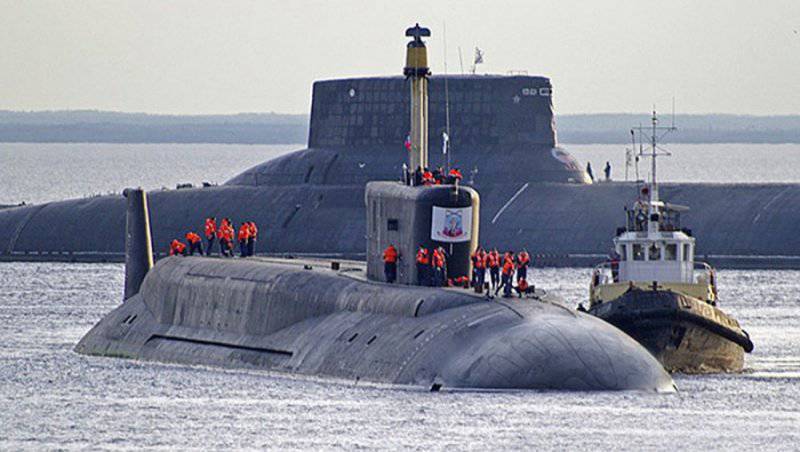
In the background, already as a backdrop for the events of the present, we have the 941 submarine, the famous Shark, the largest nuclear submarine ever built in the world.
That's about this long stories creating ships that should sail underwater and carry what is supposed to fly in space, and I will try to tell. To tell from the point of view of rockets - since it was precisely rockets and, more widely, carriers of nuclear charges and nuclear charges themselves invisibly set the design thought of the submarine builders who assembled, assembled and will “assemble boats” around a whimsical thing for a long time space and bring light and warmth to every enemy city.
It must be said that the first atomic charges were very few suitable for the purpose of their quick and quick delivery to the territory of a possible adversary.
To understand the size of the catastrophe, which pursued the first nuclear and thermonuclear devices, here is a vivid description of the path that atomic bombs traversed during 1940-1960 years:
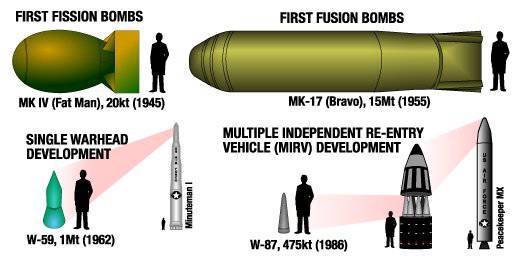
In the upper left corner is the Fat Bomb, which the US dropped on Nagasaki in 1945 year. The bomb weighed 4,6 tons and was over 1,5 meters in diameter with a length exceeding the 3 meters
Even more impressive dimensions were also found in the first thermonuclear munition “Castle Bravo”, which the Americans blew up on the Bikini Atoll.
The Shrimp device, despite the fact that it already used lithium deuteride and was much more compact than the first hydrogen test weapons (the explosion “Mike”), which the Americans themselves called only the “house with liquid hydrogen”, was in no way like a bomb. It was a stationary device weighing more than 10 tons, which in fact could not be used as real ammunition:
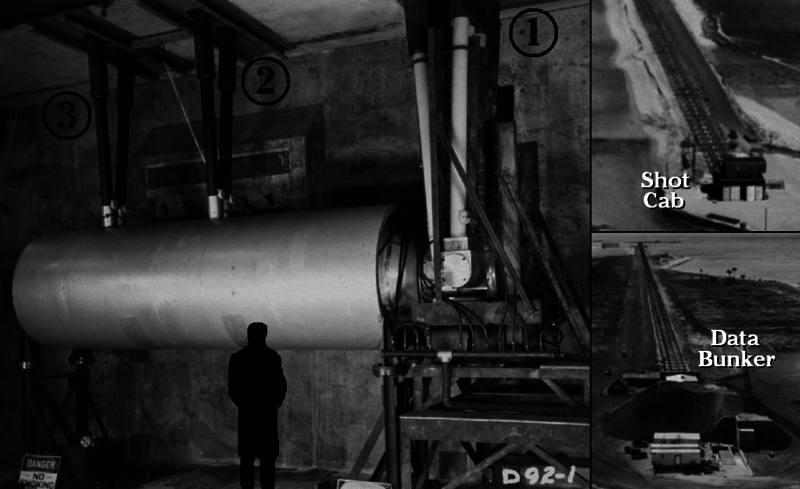
In general, the epithet "bomb", which was placed next to the "Shrimp", was quite optimistic - there was simply no sensible bomber in the world that could pull such a huge object to any significant distance. Yes, and it would have looked no less comical than the test in the Soviet Union "king-bombs" at the Novaya Zemlya test site, when the thermonuclear device had to be mounted on the external suspension of the aircraft, because of which the lines of the Tu-95 bomber turned out to be lightly coated with "pregnancy" :
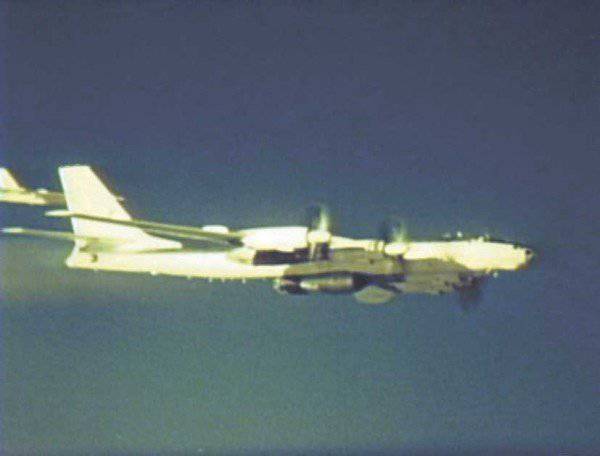
Such imperfections in the size and mass of the first nuclear and thermonuclear ammunition forced the designers to look for quite unusual at the present time technical and technological solutions for the delivery of light and heat.
Nobody dreamed of hiding the first atomic bombs at the head of a ballistic missile, because the first purely Soviet rocket P-2 / 8Ж38 (a modification of the famous German V-2) threw at 1-kilometer range only , ensuring the accuracy of hitting the whole plus or minus one and a half kilometers from a given point.
Such a blatant inaccuracy, short range and poor payload of the first Soviet ballistic missile, which was already more or less suitable for transfer to the troops, pushed the designers to ideas that were completely insane by now.
Initially, the R-2 rocket had only a high-explosive warhead with conventional explosives. Due to this, its effectiveness, in general, was not much higher than the solid aviation the bomb. In the event of a missile launch, one did not have to risk airplanes and bombers, but the experience of World War II showed that even firing at a large and long target like London with the help of V-2 missiles did not produce any real result.
Therefore, at the beginning of the 1950-ies for the P-2 rocket was designed two versions of combat units with combat radioactive substances.
In the 1940-ies in the USSR, as a result of obtaining weapons-grade plutonium and uranium, a lot of high-level waste was generated. There was really nothing to do with them, in general, then, because of the impossibility of delivering light and heat to the heads of adversaries, they decided to pour radioactive mud in the USSR.
In short, if someone read Robert Heinlein's “A Useless Solution”, then this is not fiction, but the most post-war reality.
What to do? The rocket flew badly, close by, and its launch looked like a children's round dance around a New Year tree:
Variants of warheads with combat radioactive liquids, in the best traditions of the Soviet military forces, were called very abstractly and romantically - “Geranium” and “Generator”.
The warhead "Geranium" was equipped with a radioactive liquid. Under high-altitude blasting, this liquid was sprayed, settling in the form of radioactive rain.
The warhead "Generator" differed from the "Geranium" in that the same radioactive mixture was placed at the head of the rocket not in the general capacity, but in a large number of small vessels, each of which was torn apart above the ground, that is, something like cluster munition.
In 1953, at the Kapustin Yar proving ground, they launched two launches of the P-2 missiles with the Geranium and Generator combat units.
In preparation for the launch of the Geranium rocket, a trickle of turbid liquid flowed from the head of the rocket on the launch pad. The entire launch team rushed to run - despite the strict secrecy of the launch, there were rumors about a “radioactive fluid” inside the missiles at the test site. Only the leader of the start, Professor Leonid Voskresensky, slowly rose to the installation to the height of the tail section, artistically stretched out his hand, smeared the liquid flowing through the body with his index finger, and then licked the “radioactive” finger. The warhead was only a mass-dimensional layout, filled with plain water.
The launches of the Gerani and the Generator were successful, but they did not act like that.
Tests of the same sticky and liquid military radioactive substances for "Gerani" and "Generator" were conducted in the north-western part of Lake Ladoga. We studied the extent and degree of contamination of ships and coastal objects when radioactive liquids hit them, as well as the means and methods for their deactivation. The tests of the developed compositions and devices, although they confirmed the technical capabilities of the radiological weapons, showed that it was inexpedient to continue to work — the reduction of nuclear warheads was growing at an increasing rate and the need for combat radioactive substances disappeared.
Soon, the atomic scientists created a special charge for the P-2 rocket, but it still had to make a new rocket head for it. In November 1955, flight tests of the P-2 with an enlarged head part were conducted. The nuclear warhead for the P-2 began to arrive in troops from 1956 onwards.
However, as you understand, it was still very difficult to place the entire “ground zoo” from the P-2 rocket into a very limited amount of submarine.
Therefore, the first projects of carriers of atomic weapons for the Navy looked, perhaps, no less grotesque than a rocket fueled with radioactive battle mud.
Meet the T-15 nuclear torpedo:
Yes, the sight did not deceive you. The submarine of the “627 project”, the first Soviet atomic one that was developed for the Navy of the USSR since 1953, is actually only a “shell” for the launch vehicle of the huge torpedo, which has a diameter, like the Fat Man from Nagasaki, one and a half meters.
The length of the torpedo tube was 23,5 meter (22% of the total length of the submarine). On the submarine, in addition to the one and a half meter torpedo in diameter, only the installation of two nasal, standard 533-millimeter torpedo tubes with torpedoes for self-defense was provided. Spare nuclear torpedoes were not foreseen - they simply had nowhere to be placed in the limited size of the submarine.
The mass of the T-15 torpedo was 40 tons, and the mass of its thermonuclear combat unit was about 4 tons. The main weight of the torpedo fell on the battery, which provided the torpedo speed in 29 nodes, while the range was only 30 kilometers.
At such a speed of the torpedo, when launching it in the direction of a likely enemy, even at the extreme range, the submarine of the 627 project had only about 30 minutes to get away from the epicenter of a future thermonuclear explosion.
Considering the boat’s own speed in the area of 30 nodes, the concept of “one shot” is clear: for the maximum half-hour set aside by its torpedo, the boat managed to move only 20 kilometers from the launch point, being only 50 kilometers from the fusion center “hello” to the adversary.
Which was planned to do in the 100 area of megatons of TNT equivalent. Let me remind you that the famous “tsar-bomb”, the blast wave from which twisted around the globe twice, had a power less than half, and we have a thermonuclear “tsar-torpedo” device — only 55 megatons.
Andrei Sakharov is considered the author of the idea of creating a super-powerful nuclear torpedo, who suggested using the 627 project developed by the “submarine” submarine of the XNUMX project as a “means of delivery” This is confirmed by his own memories. These torpedoes were supposed to be used against US naval bases, as well as for attacking cities on the coast, although many opposed the latter option, including naval sailors. As a result of the explosion of such a bomb would form a giant tsunami wave, which would have destroyed, along with other factors affecting the nuclear explosion, everything on the nearby coast and far into the mainland of the enemy from its coastline.
I must say that such crazy projects were then rather a necessary measure.
Before the appearance of a compact special charge for the P-2 rocket, the USSR had only about a dozen Tatiana free-fall nuclear bombs (T product) available for the USSR, except for the Gerani, Generator and T-15 projects. deliver only Tupolev Tu-4 bombers.
The Tu-4 was an exact copy of the captured American bomber B-29, which was at the disposal of the USSR at the end of the Second World War.
But in 1952, these low-speed, piston-engineered, bombers for American F-86 jet fighters were already easy targets. In addition, the Tu-4 could fly to American territories only with an intermediate landing at the ice airfield on one of the northern Soviet islands or on a floating ice floe near the North Pole. At the same time, the crew of the bomber, like the crew of the submarine, had a “one-way ticket” - there was no fuel for the return flight. The pilots of the Tu-4 bomber on completion of the mission had the only way out: to try to fly to the Mexican border and there already jump out with a parachute.
The appearance of a compact nuclear warhead finally opened the way for the installation of a ballistic missile on a submarine. But the solution of the problem with high-boiling components allowed, finally, to move from the theory of installing a rocket on a submarine to reality.
The first missile that actually hit the submarine was the P-11 / 8K11 rocket, which I already wrote about. Our legendary Scud was also the first rocket launched in the USSR not from land but from the sea.
Considering that the first American nuclear submarines of the Skate type and the experimental submarine Nautilus had only torpedo-mine weapons, and the first American missile submarine SSGN-587, the Khalibat, which entered service in 1960, was armed cruise missiles, the launch of the R-11F rocket (the F index has since marked the attitude to the fleet on the missiles), which was carried out from the experimental submarine B-67 16 of September 1955 of the year in the sea.
The submarine B-67, which launched the first ballistic missile, belonged to the “611 project” and was a diesel submarine. For the B-67, a special modernization was carried out according to the 611B project, which included the installation of two missile silos for the P-11FM nuclear ballistic missiles inside the subunit's wheelhouse.
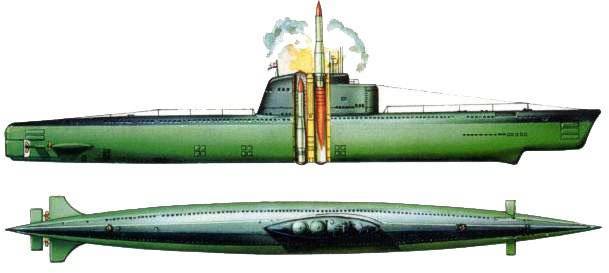
The rocket R-11F, however, did not start directly from the mine inside the submarine, as is customary now, but was moved up from the transport position, being at the time of launch over the cabin of the submarine.
This is how the world's first launch of a ballistic missile from a submarine, which was carried out in the USSR in 1955, looked like this:
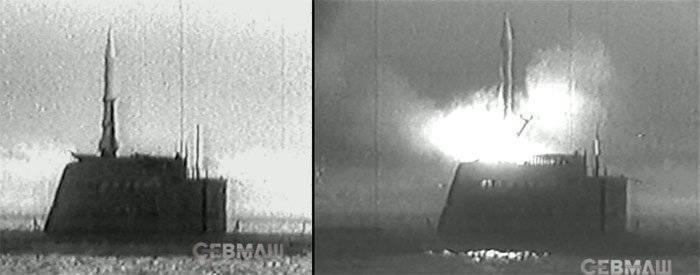
Directing the launch directly Sergei Korolev.
The R-11FM rocket then flew just 250 kilometers, but that was enough to understand: nuclear submarines have a huge future.
However, before the concept of a real SSBN (well, or SSBN, if you like) it was still a long time.
Well, the first atomic Soviet submarine of the 627 project was upgraded from the “king-torpedo” to ordinary torpedoes of the 533 caliber of a millimeter, to which at that time a small and compact nuclear charge had already been created. During the 1955-1964 period, 13 boats of the 627 project were built in the USSR. The giant T-15 torpedo was replaced with eight bow torpedo tubes of caliber 533 mm with a total ammunition load of torpedoes 20.
But a real nuclear submarine with nuclear ballistic missiles was still to be created. And this race between the USSR and the USA began in the 1960s.
Having dealt with nuclear charges and making them more or less compact, the designers faced another problem: it was just as difficult to hide in the submarine and the ballistic missile itself.
If you, of course, wanted to let it covertly, quickly and far away from the shores of a possible enemy.
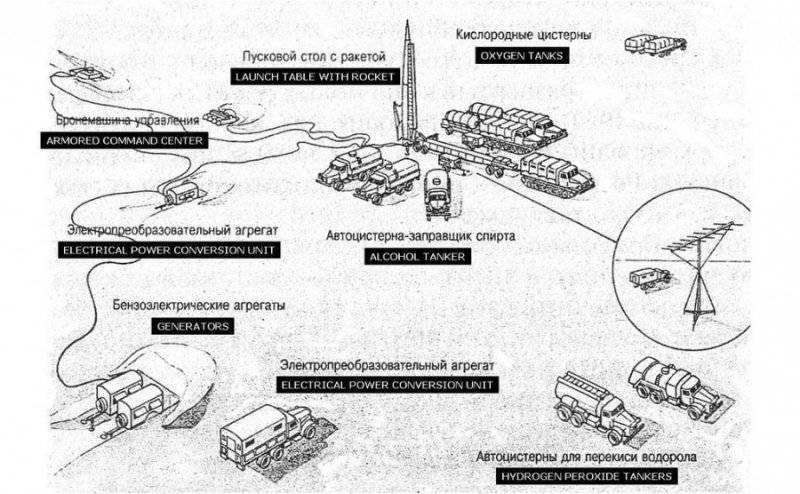
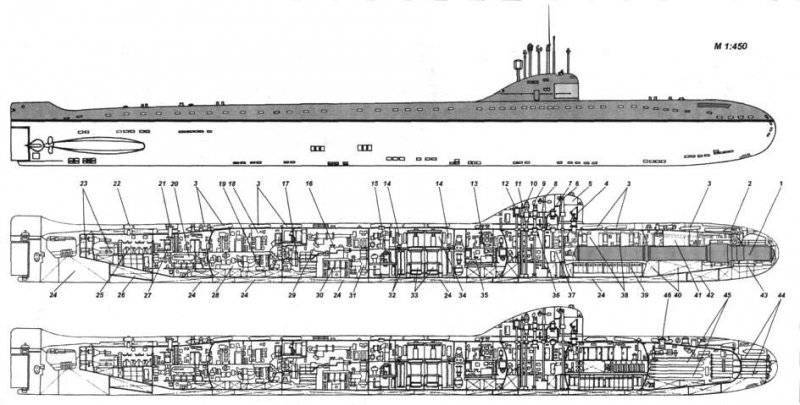
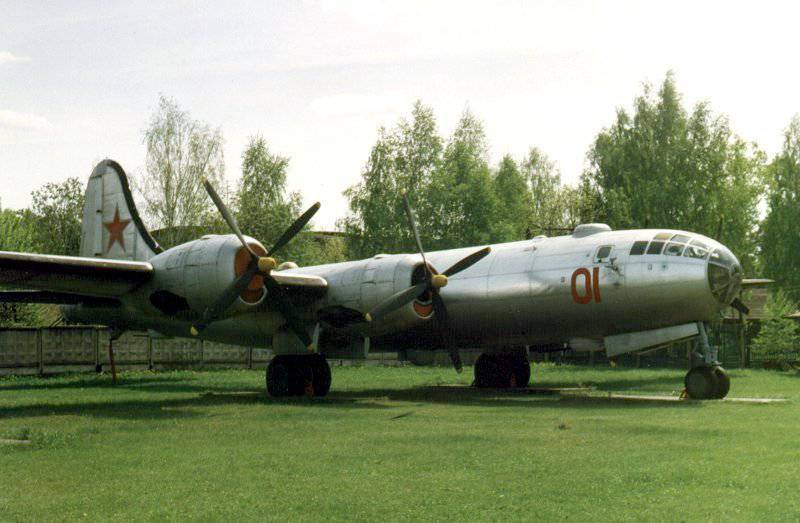
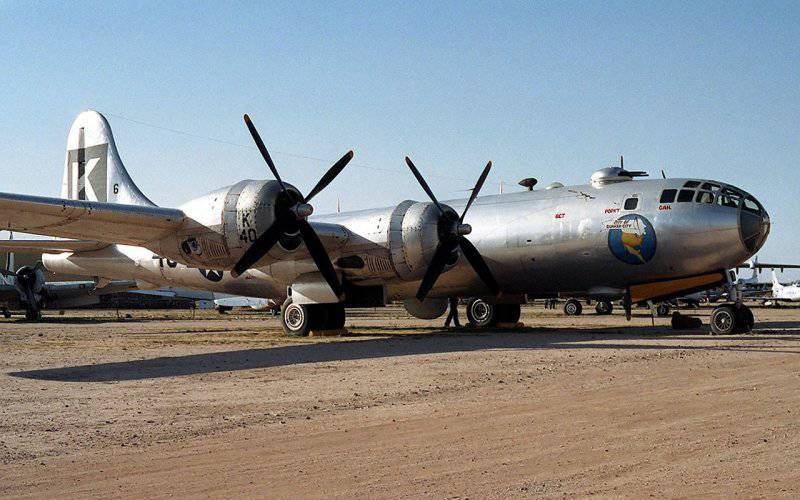
Information